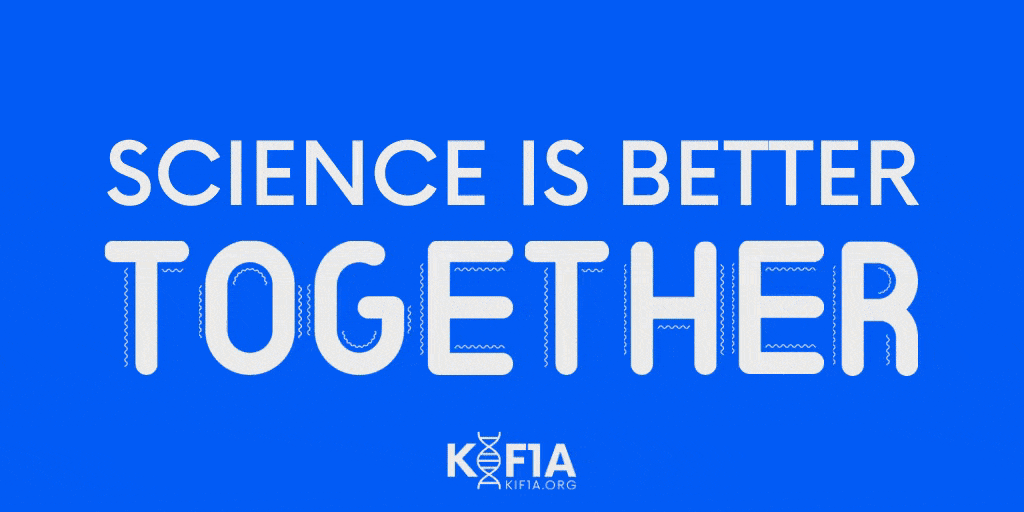#ScienceSaturday posts share relevant and exciting scientific news with the KAND community. This project is a collaboration between KIF1A.ORG’s Research Engagement Team Leader Alejandro Doval, President Kathryn Atchley and Science Communication Director Dr. Dominique Lessard. Send news suggestions to our team at impact@kif1a.org.
Calling All Researchers!
As a part of KIF1A.ORG’s Research Roundtable series, we invite you to join an open forum entitled “Help KIF1A.ORG Help You.” Want to get involved with KIF1A research and need help getting started? Have questions about how our organization supports researchers? Eager to connect your basic science research to clinical therapeutic discovery? Need help creating a pathway to build biotech/industry partnerships? We want to hear from YOU!
Are you in? To RSVP to our August 26 call CLICK HERE!

KIF1A-Related Research: From the Archives
Characterization of the Movement of the Kinesin Motor KIF1A in Living Cultured Neurons
This week in KIF1A-Related Research: From the Archives, we are featuring one of the first articles that characterized KIF1A’s movement inside of living neurons! Recording videos of KIF1A movement that is occurring inside of a cell was no easy feat almost 20 years ago when this article was published. This paper taught us more about KIF1A localization and distribution within neurons, meaning we learned more about where we would expect to find KIF1A in the different regions of a cell. While studies earlier than this paper had revealed to us that isolated KIF1A could move very quickly and efficiently on a molecular level, questions still remained about how efficient KIF1A was as a transporter within a cell like a neuron. This study revealed to us that KIF1A is indeed a highly efficient, or highly processive, molecular motor protein within neurons and highlighted the importance of KIF1A cargo transport in a cellular system.
Rare Disease News
How we accelerated clinical trials in the age of coronavirus
As we approach the six-month mark of the COVID-19 global pandemic, many of us are taking the time to reflect and comprehend the ways in which our lives have changed. However, sometimes being immersed in chaos and uncertainty can lead to important reflection and reform of the systems that govern our daily lives. Once such area that has been a topic of discussion since the beginning of this pandemic is our clinical trial systems. With limited therapeutic options for COVID-19 patients, many countries and companies are looking at ways to fast track clinical trial protocols to accelerate the discovery of new treatments. This article tells the story of the RECOVERY trial based out of the University of Oxford. Supported via the United Kingdom’s National Health Service, this trial is the biggest randomized COVID-19 clinical trial in the world thus far. The success and magnitude of this trial was a direct result of repurposing existing clinical trial infrastructure. Click the link below to learn more about RECOVERY and how we can apply lessons learned in future clinical trials.
“The RECOVERY trial had five key features that distinguish it from a standard approach. It had a short, flexible protocol — just 20 pages long — that laid out the design and data and regulatory requirements, and allowed trial arms to be halted or added. It received ethical and regulatory approval in just 9 days, compared with the standard 30–60 days. Its recruitment procedures were straightforward, with only a two-page consent form and a one-page bedside form to be completed by clinicians. It accelerated data collection and processing through NHS DigiTrials. And it quickly made results public…”
First targeted gene therapy for Wiskott-Aldrich Syndrome shows promise
Wiskott-Aldrich syndrome (WAS) is a rare genetic disorder characterized by insufficient or abnormal immune system function. Currently the only treatment for WAS is a bone marrow transplant and about one fifth of patients are unable to undergo this treatment due to insufficient donor matching. However, recent advances in gene therapy techniques have provided promising results for potential treatment of WAS. This month, research teams at the Great Ormond Street Hospital for Children and the UCL Great Ormond Street Institute of Child Health have published their work on a CRISPR-based gene therapy study using immunodeficient mice and patient-derived hematopoietic stem and progenitor cells with a 60% editing success rate. Furthermore, this study did not yield any concerning levels of toxicity, making this approach an enticing candidate for a gene therapy clinical trial in the future. To learn more about the strategy behind gene therapy, check out the video below from our friends at JAX!
Nanoparticles enhance gene therapies for eye disease
Developing a therapeutic treatment is challenging to say the least. First, a therapeutic agent (i.e. a drug) must be developed. Once this is completed, researchers are often faced with an arduous question: how are we going to get this therapeutic treatment inside of the body, delivered to where we want it to go? You may have heard a lot about the use of “viral vectors” in targeted drug delivery. While many recent advances have been made in viral vector delivery techniques, it is still very technically difficult. Because of this, researchers at the National Institute of Biomedical Imaging and Bioengineering (NIBIB) are taking a different approach: nanoparticles. In the context of drug delivery, nanoparticles are extremely small engineered compartments that can be used to deliver and release a targeted therapeutic agent. Click the button below to learn more about how NIBIB researchers are using nanoparticles in an attempt to increase the effectiveness of gene therapy for certain eye diseases. Additionally, if you want to learn more about nanoparticles and nanoscience check out the video below!

